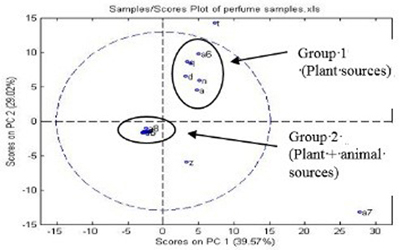Classification of perfume products using gas chromatography-mass spectrometry and pattern recognition
DOI:
https://doi.org/10.11113/mjfas.v10n3.266Keywords:
perfume products, gas chromatography-mass spectrometry, chemometric technique, principal component analysis, cluster analysis|Abstract
Perfume is a mixture of fragrant essential oils and aroma compounds, fixatives, and solvents used to give human body, objects, and living spaces a pleasant odour. Perfume compositions are mixture of natural and synthetic sources which consist of 100 or more components. The difference in composition of perfume is the main characteristics which can classify the perfume into several groups such as animal and plant sources. Therefore, correct identification of each perfume product composition is crucial in order to do the classification. The perfume products have been analyzed using gas chromatography mass spectrometry and chemometric technique. There are 34 samples of perfume products used in this article which is taken from different brand available around Skudai. Chemometric technique was applied in this research to simplify data obtained by allowing them to form classes to their respective groups. Two unsupervised pattern recognition technique namely principal component analysis (PCA) and cluster analysis were used. The perfume product samples investigated in this research can be classified into two main groups namely animal and plant sources. Principal component analysis (PCA) and cluster analysis were successfully used in classifying the perfume product according to their respective groups based on the compositional information from the chromatogram of each samples.
________________________________________
GRAPHICAL ABSTRACT

References
Mutelet, F., Ekulu, G. and Rogalski, M. (2002). Characterization of crude oils by inverse gas chromatography.J. Chromatogr. A. 969, 207-213.
Gvierson, M., Barber, J., Hunting Anthony, L.L. (1989). Natural Ingredients in Cosmetics. Cranford, USA: Micelle Press. 12-26.
Justwan, H., Dahl, B. and Isaksen, G.H. (2006). Geochemical characterisation and genetic origin of oils and condensates in the South Viking Graben, Norway.Marine and petroleum geology.23, 213-239.
Urdal, K., Vogt, N. B., Sporstol, S. P., Lichtenthaler, R. G., Mostad, H., Kolset, K., Nordenson, S. and Esbensen, K. (1986).Classification of Weathered Crude Oils Using Multimethod Chemical Analysis, Statistical Methods and SIMCA Pattern Recognition.Marine Pollution Bulletin.17, 366-373.
Davies, A. M. C. (2005). The principle of principal component analysis.Department of Statistical Science, University College London, UK.1, 35-38.
Brereton, R.G. (2009). Chemometrics for Pattern Recognition. Bristol, UK: Wiley. 1-13.
Beebe, K.R, Pell, R.J., Seasholtz, M.B. (1998). Chemometrics:A Practical Guide. New York. John Wiley &Sons.Inc, 61-65.
Yu, P. (2005). Application of Hierarchical Cluster Analysis (CLA) and Principal component analysis (PCA) in Feed Structure and Feed Molecular Chemistry Research, Using Synchroton-Based Fourier Transform Infrared (FTIR) Microspectroscopy. J. Agric. Food Chem. 53. 7115-7127.
Wise. B.M., Gallagher, N.B., Bro, R., Shaver, J.M., Windig, W., Koch, R.S. (2004). PLS_Toolbox 3.5 for use with MATLABTM. Eigenvector Res. Inc. 1-6.
Burg, Ph., Selves, J.L. and Colin, J.P. (1995). Numerical Simulation of Crude Oil Behaviour from Chromatographic Data. Anal. Chimica Acta. 317,107-125



















